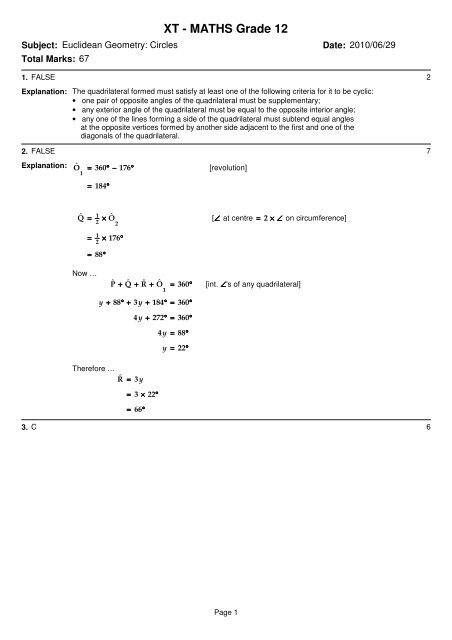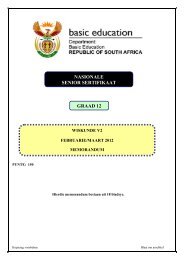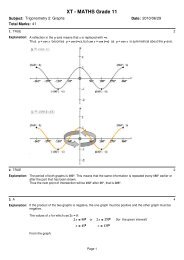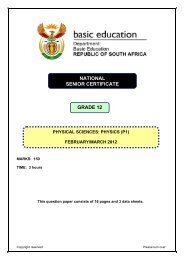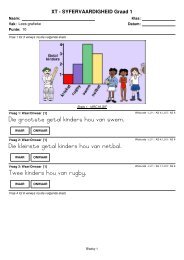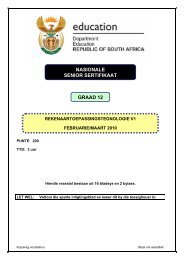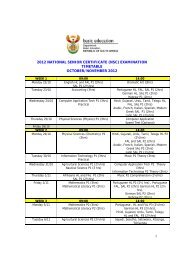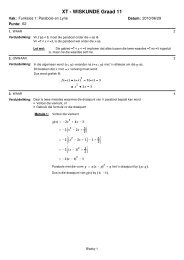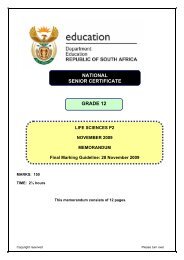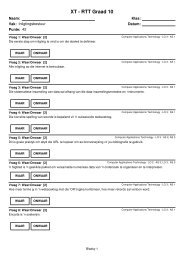XT â MATHS Grade 12 â Euclidean Geometry â Circles Memo
XT â MATHS Grade 12 â Euclidean Geometry â Circles Memo
XT â MATHS Grade 12 â Euclidean Geometry â Circles Memo
You also want an ePaper? Increase the reach of your titles
YUMPU automatically turns print PDFs into web optimized ePapers that Google loves.
Subject: <strong>Euclidean</strong> <strong>Geometry</strong>: <strong>Circles</strong><br />
Total Marks: 67<br />
<strong>XT</strong> - <strong>MATHS</strong> <strong>Grade</strong> <strong>12</strong><br />
Date: 2010/06/29<br />
1. FALSE 2<br />
Explanation:<br />
The quadrilateral formed must satisfy at least one of the following criteria for it to be cyclic:<br />
• one pair of opposite angles of the quadrilateral must be supplementary;<br />
• any exterior angle of the quadrilateral must be equal to the opposite interior angle;<br />
• any one of the lines forming a side of the quadrilateral must subtend equal angles<br />
at the opposite vertices formed by another side adjacent to the first and one of the<br />
diagonals of the quadrilateral.<br />
2. FALSE 7<br />
Explanation:<br />
Ô = 360 ° − 176<br />
°<br />
1<br />
= 184<br />
°<br />
[revolution]<br />
1<br />
Qˆ<br />
= × Oˆ<br />
[ ∠ at centre = 2<br />
× ∠<br />
on circumference]<br />
2 2<br />
1<br />
2<br />
= × 176<br />
°<br />
= 88<br />
°<br />
Now …<br />
Pˆ<br />
+ Qˆ<br />
+ Rˆ<br />
+ Oˆ<br />
= 360<br />
° [int. ∠<br />
's of any quadrilateral]<br />
y<br />
+ 88 ° + 3y<br />
+ 184 ° = 360<br />
°<br />
4y<br />
+ 272 ° = 360<br />
°<br />
4y<br />
= 88<br />
°<br />
1<br />
y<br />
= 22<br />
°<br />
Therefore …<br />
ˆR = 3y<br />
= 3 × 22<br />
°<br />
= 66<br />
°<br />
3. C 6<br />
Page 1
Explanation:<br />
Let QPR ˆ = x.<br />
Therefore:<br />
ˆT = x [tangent QP-chord RP]<br />
QPR ˆ<br />
= VPS ˆ [vert. opp. ∠<br />
's]<br />
Therefore:<br />
ˆM = x [tangent PV-chord PS]<br />
Therefore:<br />
Tˆ<br />
=<br />
Mˆ<br />
Therefore, the alternate angles are equal which means that they must lie between parallel lines.<br />
Thus:<br />
TR SM<br />
If RT QPV, then Rˆ<br />
and QPR ˆ would need to be equal. There is no way of proving these angles equal.<br />
If MS QPV, then Sˆ<br />
and VPS ˆ would need to be equal. There is no way of proving these angles equal.<br />
4. D 5<br />
Explanation:<br />
CE<br />
=<br />
DE<br />
[given]<br />
1<br />
∴ Cˆ<br />
= ⎡<br />
180 ° − CED ˆ<br />
⎤<br />
[int. ∠ 's of isosc. ∆<br />
CED]<br />
2<br />
⎣<br />
⎦<br />
1<br />
2<br />
= ⎡<br />
⎣<br />
180 ° − 28<br />
°<br />
⎤<br />
⎦<br />
1<br />
2<br />
= × 152<br />
°<br />
= 76<br />
°<br />
Now ...<br />
EBD ˆ = Cˆ<br />
[both subtended by chord DE]<br />
= 76<br />
°<br />
Therefore:<br />
ABE ˆ<br />
= 180 ° − EBD ˆ [supplementary ∠<br />
's]<br />
= 180 ° − 76<br />
°<br />
= 104<br />
°<br />
5. TRUE 4<br />
Page 2
Explanation:<br />
CDB ˆ<br />
= DBF ˆ<br />
[alt. ∠<br />
's; BF CDE]<br />
But ...<br />
CDB ˆ = Fˆ<br />
[Theorem: tangent CDE-chord BD]<br />
Therefore ...<br />
DBF ˆ<br />
=<br />
Fˆ<br />
This means that BD = FD.<br />
∆ BDF<br />
will therefore be an isosceles triangle.<br />
6. D 2<br />
Explanation:<br />
Cˆ<br />
: Aˆ<br />
= Cˆ<br />
[int. ∠ equal to opp. ext. ∠<br />
of cyc. quad. ABCD]<br />
1 1<br />
Cˆ<br />
: Aˆ<br />
+ Cˆ<br />
= 180 ° [opp. ∠<br />
's of cyc. quad. ABCD are suppl., not equal]<br />
2 2<br />
Bˆ<br />
: Bˆ<br />
is not an opposite exterior angle to Â, as they share the common arm ABF.<br />
1 1<br />
Dˆ : Dˆ is not an opposite exterior angle to Aˆ<br />
, as they share the common arm ADH.<br />
1 1<br />
7. 96°<br />
96<br />
6<br />
Explanation:<br />
Ô = 360 ° −<br />
3 x<br />
2<br />
And ...<br />
Therefore:<br />
( )<br />
[revolution]<br />
Oˆ<br />
= 2Aˆ<br />
[major arc BC subtends centre Oˆ<br />
and circumference Aˆ<br />
]<br />
2 2<br />
( x )<br />
360 ° − 3 x<br />
= 2 + 40<br />
°<br />
∴ 360 ° − 3 x<br />
= 2 x<br />
+ 80<br />
°<br />
∴ 280 ° =<br />
5x<br />
∴ 56<br />
° =<br />
x<br />
Now:<br />
 = 56 ° + 40<br />
°<br />
= 96<br />
°<br />
8. 72°<br />
72 degrees<br />
2<br />
Explanation:<br />
As DBC ˆ is the angle between the tangent and the chord and Eˆ<br />
is the angle in the<br />
alternate segment of the circle, Eˆ<br />
will be equal to DBC ˆ .<br />
Therefore:<br />
Ê = 72°<br />
9. ADC<br />
CDA<br />
ADG<br />
GDA<br />
2<br />
Page 3
Explanation:<br />
The exterior angle of a cyclic quadrilateral is equal to the opposite interior angle of<br />
the cyclic quadrilateral.<br />
BCD ˆ , BAD ˆ , ABC ˆ and ADC ˆ are all interior angles of ABCD. The only angle<br />
opposite FBA ˆ is ADC ˆ .<br />
10. (1) 33°<br />
7<br />
(2) an isosceles triangle<br />
(3) 66°<br />
Explanation:<br />
(1) ACB ˆ<br />
= 90<br />
°<br />
[subtended by diameter]<br />
∴ ACD ˆ = 90° [supplementary ∠<br />
's]<br />
Now ...<br />
CAD ˆ<br />
= 180 ° − 90 ° − Dˆ<br />
[int. ∠'s of right-angled triangle]<br />
= 180 ° − 90 ° − 57<br />
°<br />
= 33<br />
°<br />
(2) EA = EC [tangents from same point ( E)]<br />
Therefore:<br />
∆<br />
AEC is isosceles<br />
[base ∠<br />
's are equal]<br />
(3) CED ˆ<br />
= ACE ˆ<br />
+ CAE ˆ<br />
[ext. ∠ of ∆<br />
AEC]<br />
= 33 ° + 33<br />
°<br />
= 66<br />
°<br />
11. (1) WU = UT<br />
8<br />
(2) UT subtends equal ∠'s<br />
(3) converse of tangent-chord theorem<br />
Explanation:<br />
(1) Pˆ<br />
= Pˆ<br />
[subtended by equal chords WU and UT]<br />
1 2<br />
(2) Pˆ<br />
= Wˆ<br />
[ UT subtends equal ∠<br />
's on circumference]<br />
2 2<br />
(3) Wˆ<br />
= Uˆ<br />
[alternate ∠<br />
's; WT SU]<br />
2 1<br />
From all the above:<br />
Therefore:<br />
SU is a tangent.<br />
Uˆ<br />
= Pˆ<br />
1 1<br />
[converse of tan-chord theorem]<br />
<strong>12</strong>. (1) 6<br />
ext. ∠ equal to opp. int. ∠ of cyclic quadrilateral DCEP<br />
(2) alt. ∠ 's; CD ll AB<br />
(3)<br />
ˆF<br />
2<br />
(4) ext. ∠ of ABFE is equal to opp. int. ∠ of ABFE<br />
Page 4
Explanation:<br />
(1) ˆP = C ˆ = x [ext. ∠ of cyc. quad. DCEP is equal to opp. int. ∠<br />
of DCEP ]<br />
1 1<br />
(2) Â = Cˆ<br />
= x [alternate ∠<br />
's; DC AB]<br />
2 1<br />
(3) Pˆ<br />
= Fˆ<br />
= x [alternate ∠<br />
's; AD BC]<br />
1 2<br />
(4) From (1), (2) and (3):<br />
Â<br />
=<br />
ˆF<br />
2 2<br />
Thus, the exterior angle of ABFE is equal to the opposite interior angle of ABFE.<br />
Therefore, ABFE is a cyclic quadrilateral.<br />
13. TRUE 5<br />
Explanation:<br />
RSU ˆ<br />
= 90 ° [ ∠<br />
subtended by diameter RU]<br />
UST ˆ = Rˆ<br />
[Theorem: tangent ST-chord SU]<br />
= 36<br />
°<br />
TUS ˆ<br />
= <strong>12</strong>6<br />
°<br />
ˆT = 180 ° − <strong>12</strong>6 ° − 36<br />
° [sum int angles of<br />
∆<br />
RST]<br />
= 18°<br />
As with all geometry riders, there are many ways of answering the question. This is probably the shortest.<br />
14. B 4<br />
Explanation:<br />
CB = CD [tangents from same point C]<br />
1<br />
∴ CDB ˆ<br />
= ⎡<br />
180 ° − Cˆ<br />
⎤<br />
[int. ∠ 's of isosc. ∆<br />
CDB]<br />
2<br />
⎣<br />
⎦<br />
1<br />
= ⎡ 180 42<br />
2<br />
⎣<br />
° − °<br />
⎤<br />
⎦<br />
1<br />
= × 138<br />
°<br />
2<br />
= 69<br />
°<br />
Now:<br />
Fˆ<br />
= CDB ˆ<br />
[ ∠ between tangent CDE and chord BD]<br />
= 69<br />
°<br />
15. perpendicular 1<br />
Explanation:<br />
The converse of this theorem states:<br />
If the radius and a chord of a circle are perpendicular to each other,<br />
then the radius will bisect that chord.<br />
15 Questions, 5 Pages<br />
Page 5


